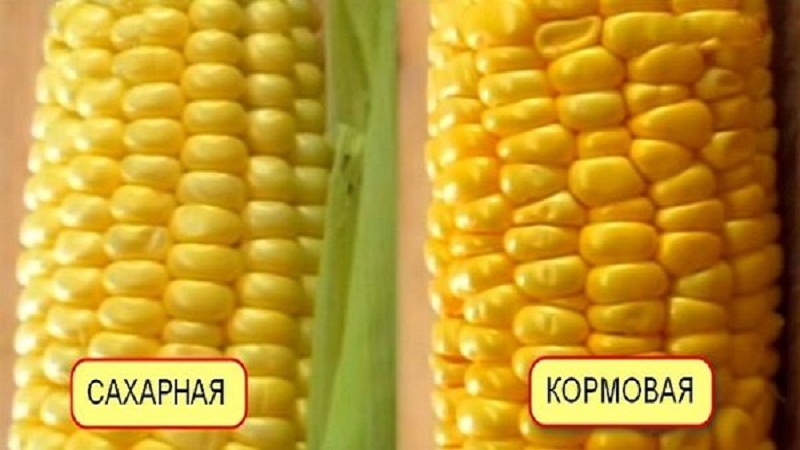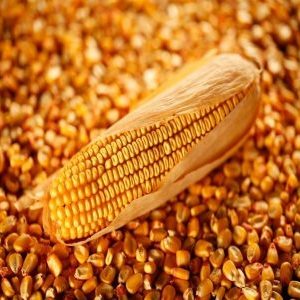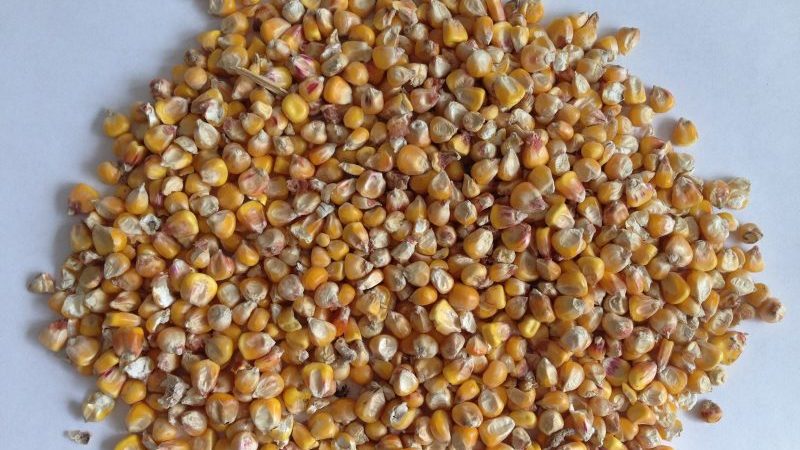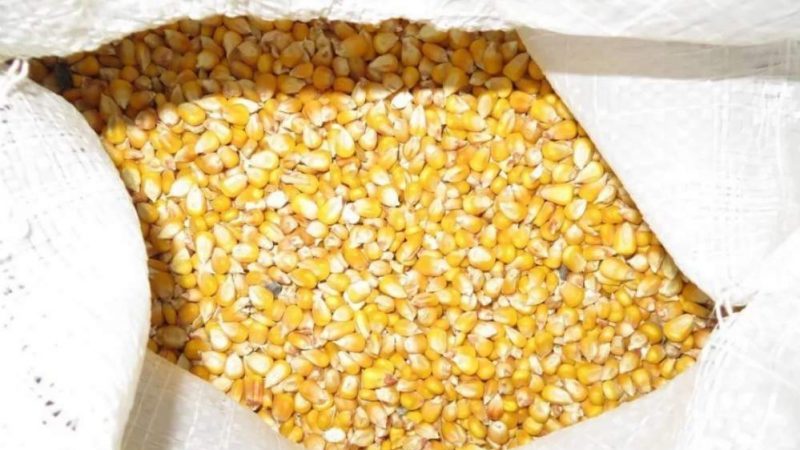What is feed corn, how is it grown and where is it used
Global production of corn for grain in 2018 was about 960 million tons, and volumes continue to increase. Two thirds of the gross harvest of the crop is spent on feed for farm animals and poultry.
What is the difference between feed (feed) corn from food, we will talk about the advantages and disadvantages of feeding livestock with corn in the article.
The content of the article
What is feed corn
Feed corn is a group of varieties that are unpretentious to growing conditions, but have reduced palatability... The grain of these plants is used as a nutritious and inexpensive feed for farm animals: cattle, pigs, poultry.

The value of corn as forage
Corn grain feed features:
- high content of carbohydrates (not less than 70%);
- a large amount of fat (about 8%);
- low protein content (up to 10%).
1 kg of dry matter contains at least 15 MJ of metabolic energy (EE). For comparison, the energy value of feed wheat is no more than 12 MJ / kg OE.
Reference. Metabolic energy - the amount of energy absorbed after digestion of feed substances. It is calculated as the difference between the energy value of the diet and energy losses with feces, urine and intestinal gases (methane).
Grain grain is rich in vitamins (especially group B) and minerals (magnesium, sodium, iron).
This feed contains essential amino acids. 1 kg contains 1.01 mg of lysine, 2.05 mg of tryptophan, 4.99 mg of tyrosine, 4.6 mg of arginine.
Animals readily eat corn-based diets.
How to distinguish from food
Sometimes unscrupulous growers pass off cheap feed maize as more expensive food varieties. The table will help to distinguish the varieties of cereal.
| Sign | Stern | Food |
| Ear shape | Slim, elongated | Thick, short |
| Color of grains of technical ripeness | Bright yellow or orange | Pale yellow, cream |
| Taste qualities | Unsweetened, harsh texture even after extended boiling | Delicate, juicy, sweet... The grains are soft, do not require prolonged heat treatment |
The photo will help you better understand the differences between the forage and food plants.

Features of growing and storage
Cultivation technology, post-harvest processing and storage feed and edible corn are similar.
The peculiarity of the forage variety is that it is less demanding on heat and sun. Therefore, forage varieties are successfully cultivated even in northern agricultural regions.
Tillage
Corn is undemanding to its predecessors and gives good yields with proper agricultural technology, even in monoculture.
The plant prefers loose soils, therefore, autumn plowing is carried out to a depth of 20-25 cm. In spring, the plow is harrowed and, as the weeds grow, they are cultivated 1-2 times. The last presowing cultivation to the depth of seeding is done simultaneously with the introduction of herbicides.
Fertilizer
Before plowing, potassium-phosphorus fertilizers are applied at the rate of 60-90 kg of phosphorus and 40-60 kg of potassium per hectare and rotted manure in the amount of 30-40 t / ha, as well as 30 kg / ha of nitrogen fertilizers in the ammonia form.
Before the first cultivation, the soil is fed with ammonium nitrate at the rate of 20-30 kg / ha.
Sowing
Sorted and treated seeds are used.Sowing of cereals begins when the sowing layer of soil warms up to + 10–12 ºС. The optimum seeding depth is 6-8 cm, when planted in heavy clay soils it is reduced to 4-5 cm. Dry weather requires an increase in the sowing depth to 10-12 cm.
The row spacing should be 60-70 cm. Seed consumption varies depending on the variety, region and purpose and ranges from 10 to 25 kg per hectare.
Care
Crop care consists in loosening, weeding, disease control and pests.
2-3 inter-row cultivation is carried out per season:
- the first - in the phase of 3-5 leaves;
- the second - two weeks later when weeds and soil crust appear;
- the latter at a plant height of 60-70 cm.
Diseases and pests are fought with protective drugs, depending on the species.
Cleaning
Harvesting begins at the stage of grain biological maturity. The dry matter content reaches 60%, the grains become brightly colored, the leaves and stems turn yellow. During this period, the ear weight is at its maximum.
On a note! The reference point for the start of harvesting is the appearance of a "black dot" at the base of the corn grain.
To collect grain for fodder purposes, combine harvesting with threshing of cobs with self-propelled units KSKU-6 is used.
Post-harvest grain processing
After harvesting, the corn is cleaned and sorted on air-sieve separators. Grain with a moisture content of less than 16% is sent for storage, with a higher moisture content - for drying in mine, column or bunker dryers. For feeding purposes, drying is carried out at a temperature not exceeding 50 ° C.
After drying, the grain must be cooled. The temperature of the maize should not exceed the ambient temperature by more than 10 ° C before backfilling in the store.
Further storage
Corn grain is stored in bulk in warehouses, in silos of elevators, in bunker storages with a moisture content of 15-16%.
During storage control temperature, humidity, color, odor, product purity. Particular attention is paid to the degree of infestation by pests and diseases. All of the above indicators must comply with the standards of GOST R 53903-2010 “Feed corn. Technical conditions ".
How to use
The use of corn as feed has its own nuances. Since the cereal is poor in proteins, it is necessary to mix wheat or legumes fodder with it: soybeans, peas, lupine.
Such mixtures are used for fattening pigs, poultry, cattle.
Feeds containing corn are ideal for young stock. Due to the small amount of fiber, they are completely absorbed by the body of young animals.
There are different types of corn feed:
- canned or dried grain;
- cornflakes;
- cob flour;
- crushed grain.
Animals like corn feeds and experienced farmers advise to introduce them into the diet carefully to avoid digestive disorders associated with overeating.

Incorporation of forage into feed
The use of maize forage for feeding cattle, pigs and poultry is different, as different animal species have different needs.
Poultry feed
For laying hens, it is recommended to add corn kernels in an amount not exceeding 20%. Otherwise, there is a risk of obesity and reduced productivity.
On a note! In winter, the proportion of corn in the diet of poultry is increased to replenish the energy expended to maintain body temperature.
Fattening individuals are allowed to feed with mixtures, which include up to 40% of corn forage. Weight gain occurs quickly and the quality of the meat does not suffer.
Is it possible to feed pigs with corn
Pig farms use up to 40% of this type of forage to accelerate fattening. Be sure to combine it with high-protein feed: peas, oilcake, hay from legumes.
reference... Lysine, which is abundant in corn kernels, is essential for muscle protein synthesis and promotes rapid weight gain.
Pigs are fed only with crushed grain, since their digestive juices do not digest the hard shell.
Fattening of cattle (cattle)
For fattening cattle, feed corn is used in various forms:
- Cob flour Is ground corn cobs. The rods make up about 20% of the cob mass, so the nutritional value of this feed is lower than that of the grains. Flour is used in the early stages of fattening in an amount not exceeding 50% of the total weight of the diet.
- Up to 40% whole or crushed grain is included in highly concentrated feed... The use of this type of forage minimizes manual labor when preparing and dispensing forage.
- Corn flakes are obtained by steaming grain for 10-15 minutes... At the same time, about 50% of the starch is gelatinized, this contributes to better digestibility. Flakes are used as an additive to concentrates and bulk feed (hay, haylage, silage, stillage, fruit pomace).
The cost

The average cost of feed corn and feed wheat depends on the product class, region, and delivery volume.
So in the Krasnodar Territory you can find corn fodder corn 1st class at a price of 9,000 rubles per ton.
But in the Urals, for example, in the Sverdlovsk region, the price for corn of the same quality will be from 17,000 rubles per ton. With a purchase volume of 20 tons, suppliers will reduce the price to 11,500-12,000 rubles.
Conclusion
Feed corn is used to feed farm animals. It is used for fattening livestock in the form of whole or crushed grain, cob flour or flakes to accelerate weight gain. Differs from food in brighter and longer cobs, tough grain texture and worse taste.
This is one of the most nutritious crops, but it is mainly used in mixtures with other feeds: feed wheat, peas. Eating only corn in the diet leads to nutrient imbalances, digestive upsets in animals, obesity, and decreased productivity. The average feed corn price is broadly comparable to feed wheat prices.